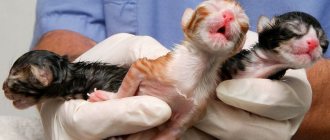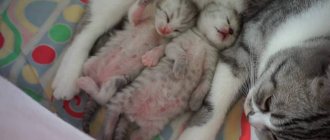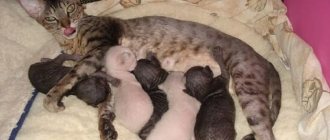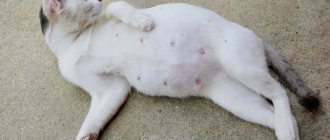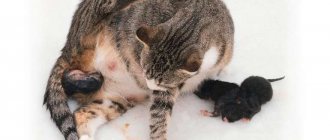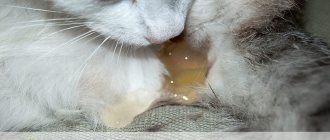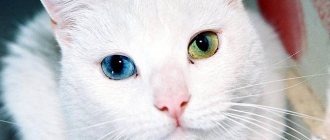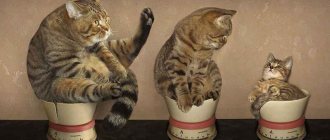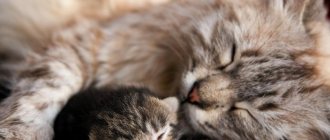Save the article:
If you are a happy cat owner, then without sterilizing your pet, sooner or later she will give you a litter of wonderful kittens. It’s good if this event is planned, then the cat will receive the nutrition, care and attention of all family members necessary during pregnancy. In this case, the cat’s birth will take place under the close supervision of the owner or veterinarian, which will help cope with possible difficulties or complications.
Although childbirth is a natural process, unplanned situations cannot be ruled out, so it is worth preparing for the climax long before it begins, which is what this article will help you with.
global $ads_google; //data-ad-slot=”2475549904″ $ads_google = empty($ads_google) ? false : true; ?> if ($ads_google == false) {?> $ads_google = true; ?> } ?>
How to prepare a cat for birth
A caring owner begins to prepare the cat for childbirth even before mating begins.
It is important to make sure that the pussy is healthy: an active lifestyle of the animal will contribute to the normal course of pregnancy and childbirth. However, towards the end of the term, it is better to ensure that the cat does not try to “take heights”, does not jump from cabinets and other high objects in the house: it can easily fall on its stomach.
On the contrary, you should try to stimulate British cats during pregnancy - these sloths are quite capable of lounging on the bed for a long period of time. And low mobility will not lead to a good result.
It is better to contact the veterinary clinic in advance and find out whether you can get an urgent consultation at any time of the day at “hour X”, and whether the institution provides the opportunity to give birth to cats at home .
Preparing the birth site
Just as a woman needs a breeding room, a cat needs a place to give birth to her offspring. It is best if it is something resembling a house for giving birth to a cat. In this place, not only will the fluffy balls be born, but also their first weeks of life will pass.
Why is it so important to prepare a place for your cat to give birth in advance? If she does not feel calm and protected, she will begin tossing around before the onset of labor, and then frantically dragging the kittens in search of a safe place.
How to help your beloved pussy during childbirth? Take care of everything in advance! What to make a house from: any spacious box will do, preferably with a removable top lid. A disposable absorbent diaper is placed in it. It makes sense to prepare in advance all the items that will help during obstetrics and place them close to the “maternity” house.
What absolutely should not be done
Sometimes the owner of a mustachioed friend can harm the animal due to inexperience. To prevent this from happening, take a close look at the list of things that are strictly forbidden to do when giving birth to a cat:
- Do not pull a newborn cat by the head or neck. It is also forbidden to pull too hard on just one paw.
- It is prohibited to use antiseptics that are intended for treating human wounds.
- Do not allow a giving birth cat to eat more than two placentas.
- It is prohibited to turn on bright lights in the maternity ward. Moreover, it should not be included in the first 2-3 weeks of a kitten’s life, as this can cause cataracts.
- In the first 2-3 hours, try not to pick up newborns. Leave them in the care of the mother: she will lick and warm the babies on her own.
Did you know? The cat sees practically nothing half a meter in front of him. That is why she can look for a long time for a tasty treat that you gave her right under her nose.
Never panic. Before giving birth, check your first aid kit and get ready, because usually there are no problems.
First birth of a cat
Starting from 7-9 months, the cat is capable of reproduction. But don’t rush things: it’s much better if the pussy turns one year old, when 3-4 heats have passed. If the mating is successful, the cat's birth calendar will help calculate the timing of the birth of the offspring.
The first time is scary for everyone: both the cat and the owner. But nature took care of the animal’s strong instincts, so sometimes it’s enough for a person to just be nearby.
The first birth is quite normal if the cat is healthy. First, contractions intensify, followed by a reduction in the intervals between them.
After pushing, the baby appears, but first amniotic fluid will come out of the birth canal. The cat will want to sit down while the kitten is coming out, this should not be allowed!
The interval between the appearance of kittens during the first birth can frighten the owner - a break of up to one and a half hours is considered the norm, and labor itself lasts from several hours to one day. In some cases, labor lasts up to 36 hours
Since the cat is inexperienced, you can help her during childbirth and cut the umbilical cord with scissors at a distance of 2 cm from the kitten’s belly.
Maternal instinct
If the birth went well, the cat is happy, and the kittens are healthy, there is no reason to worry. Nature has built into the pet a program for caring for the offspring, which the cat will carry out within the allotted time. No one can take care of the little ones better than the mother herself.
But it wouldn’t hurt to take care of the cat. The pet was very tired and spent a lot of energy and nerves on the difficult process of childbirth. Now she faces an equally difficult task - to produce all her offspring. A cat needs a rich, complete diet that contains as much protein as possible and all the beneficial vitamins. The pet will share all this wealth with the kittens, feeding them with milk. By 3 weeks of life, babies can already eat on their own, and they can be placed in new hands.
Signs of labor in a cat
In order not to miss the onset of labor, owners carefully observe how the cat behaves before giving birth:
- a few weeks before lambing, you can easily notice the enlargement of the mammary glands;
- 1-2 days before the important moment, colostrum is slowly released;
- unusual behavior of a cat is difficult to ignore: this is the search and arrangement of a “nest”, changes in mood, anxiety, desire to hide, or extraordinary affection;
- drop in body temperature to 37°;
- appetite may disappear completely;
- The cat often licks the genitals.
The main thing is to let the pet feel that she is not alone: talk to her tenderly, pet her, arrange a House for her in a secluded corner.
global $ads_google; //data-ad-slot=”2475549904″ $ads_google = empty($ads_google) ? false : true; ?> if ($ads_google == false) {?>
$ads_google = true; ?> } ?>
Stages of lambing for a cat
Labor is divided into three stages:
- Contraction of the uterus and its gradual opening. The external symptom is discharge - the mucous plug that covers the entrance to the cervix comes out. Contractions appear and become more frequent.
- Increased frequency of contractions, complete opening of the cervix. The movement of the fetus along the birth canal into the second phase is accompanied by the mother cat’s attempts to push the baby out: the animal tenses. Kittens are born mainly in the amniotic sac. If the new mother did not help the child cleanse himself of it and did not lick it, then a person should help - carefully use scissors to make an incision on the bubble in the area of the muzzle, and the kitten itself is wiped with a cloth. Usually the female, on her own, carries out the procedure of breaking the bladder and licking its remains from the kitten’s body. The duration is 5-60 minutes.
The kitten did not come out an hour after the start of this stage? Urgent call to the vet!
- Once the baby is born, the placenta begins to come out, which the mother can eat after the kitten has been licked. It is better to remember how many placentas came out - there should be as many of them as kittens.
The kitten finds the nipple, labor resumes, and the next cub appears. The interval between two kittens can be from 10 to 60 minutes.
The whole process takes on average 6 hours.
And here comes the baby
As soon as the amniotic sac ruptures, it is time to wait for the arrival of your first baby. First, amniotic fluid comes out, which softens the birth canal. In a few minutes the first kitten should appear. Some pets give birth to their entire litter within 5 minutes of each other. Others need half an hour for each furry angel. It is impossible to predict how long it will take a cat to cope. But if 30 minutes have passed after the birth of the first kitten, and the brothers still do not leave the womb, you need to urgently take action.
The birth should end within 2-4 hours; after the birth of each baby, the cat, armed with natural instincts, begins to play the role of mother. She meets the kitten, sniffs it, and immediately licks its face. After which it gnaws the umbilical cord and eats all unnecessary amniotic membranes. The placenta leaves the uterus on its own. Owners should not be frightened by the fact that the cat eats the afterbirth. But it is important to know that if your pet has a gastrointestinal disorder, the placenta in the stomach may be to blame.
Giving birth to a cat at home
A responsible owner should know how to give birth to a beloved cat . First, prepare everything you need:
- a house that the cat will examine and “accept” in advance;
- towels or absorbent diapers;
- clean cloths or gauze;
- thick silk thread;
- scissors with rounded ends;
- alcohol for disinfecting scissors;
- hydrogen peroxide;
- streptocide in powder form;
- a pipette or syringe that can be used to suck out liquid from the baby’s nose;
- afterbirth bowl;
- warmer.
Easy birth
A cat's birth is considered easy when there is no need for human intervention. It will be enough to simply be close to the woman in labor. The main thing you need to take care of is that the mother should not accidentally crush her offspring. It is also important to monitor whether each afterbirth has come out. If suddenly some placenta is missing, then the cat’s discharge is observed for several more hours; the process may take a little longer.
An easy birth is not characterized by pus, mucus and blood.
Middle birth
Sometimes some complications arise during home birth. If the process is delayed, you need to stroke the cat from the side of the neck to the uterus.
If the cat is distracted and does not chew the umbilical cord, a person does this, treating the cut site with iodine. The newborn may not breathe: minor resuscitation will be required. The respiratory tract is cleared of mucus using a pipette or suction, and the oral cavity is examined. Anything that should not be there is removed with a rubber bulb. If breathing does not appear, the baby is picked up and carefully folded in half - several times in a row. You can also rub the baby with a rough towel and gently shake it upside down.
Difficult birth
global $ads_google;
//data-ad-slot=”2475549904″ $ads_google = empty($ads_google) ? false : true; ?> if ($ads_google == false) {?> $ads_google = true; ?> } ?> Childbirth turns out to be difficult when, despite everything, the kitten is not born on its own: the baby gets stuck in the birth canal, or two babies try to be born at the same time. Before calling the veterinarian and hoping for a caesarean section, there are a number of independent steps to take.
You need to understand that it is better to act and help the cat during childbirth than to later regret the misfortune that happened.
If labor stops or its result is zero, the cat can be taken for an ultrasound or x-ray. It may turn out that the kitten has died, or it is extremely large and has blocked the exit.
Sometimes it is necessary to turn the kitten over: a gloved index finger, lubricated with Vaseline, is inserted into the vagina. You need to carefully push the baby back and try to turn him over. If it is simply stuck, then it is picked up under the hanger and carefully pulled out with attempts.
Induction of labor
If the due date has come, the cat’s body temperature has dropped to 37°C, more than two days have passed, then you need to know how to induce labor in a cat. First, they try simple remedies: massage the tummy and nipples: this will cause the production of oxytocin, and it will start the process of contractions. It is dangerous to administer oxytocin on your own - physiological unpreparedness for lambing can lead to cervical rupture.
If two days have already passed, signs of labor are evident, but the process has not started, then contact a veterinarian.
Important facts
An owner planning to breed offspring from his pet should know that:
- The standard gestation time is approximately two months (65 days +/-2). In some cats (for example, the Siamese breed), pregnancy can reach 70 days. Childbirth before 60 days is very dangerous; premature babies have very little chance of surviving.
- A pregnant cat cannot be treated with antibiotics, anthelmintics and drugs against ectoparasites; it is unacceptable to vaccinate the animal. All these activities must be carried out before the planned mating. In general, any medications for a pregnant pussy are given only according to the doctor’s decision and if it is vitally necessary.
- A cat giving birth for the first time can produce litters of 1 to 7 cubs . These are characteristics of the breed, heredity and other factors.
Possible complications
Cats are naturally strong creatures, but sometimes complications still occur. This was especially influenced by breeding selection. Observations have shown that Persian and Siamese cats often “delight” their owners with dystocia—difficult childbirth. When choosing a female kitten, it is better to immediately ask the breeders how the birth of kittens for this particular breed goes.
Bloody discharge in a cat after birth
Sometimes during labor a cat notices ichor oozing out. This is most often described as “my cat peed blood.” This is quite normal if there is little bleeding.
The alarming symptom normally disappears completely two days after lambing.
Sometimes there are really serious problems, expressed by bleeding from the vagina. Blood may have accumulated in the uterus, or if there are tears in the uterus or vulva. If a caesarean section was performed, then the blood may indicate broken sutures. But this is not just some bleeding, but really heavy bleeding that does not stop after 10 minutes. In this case, urgent veterinary help is needed.
The cat does not have milk after giving birth
First, felines, like humans, secrete colostrum. But when does a cat produce milk after giving birth? Colostrum is milk, only with a slightly modified composition. Colostrum contains a huge amount of maternal antibodies. After 2-3 days, colostrum is replaced with full-fledged nutritious milk. Thanks to nature, which, through the process of evolution, “thought out” everything, and the cat itself feeds its offspring!
But what if the cat gave birth, but there is no milk? There are several reasons: stress during a difficult birth, fear of the first-born cat, dormant maternal instinct.
The animal is provided with a comfortable environment, a nutritious, balanced menu, and milk is not spared. The bowl with food and drink is placed closer to the cat family. If food is far away, the mother may fear for her offspring, which also affects the quality and quantity of milk.
If milk does not appear, you will have to feed the newborn kittens yourself.
After giving birth, the cat came out with a bladder
Sometimes you can see a bubble coming out of the cat. Usually, this is the amniotic membrane - the kitten was in it before birth. During the normal course of labor, such a bubble ruptures inside the animal.
Sometimes during labor a bubble appears first. The cat may try to tear it apart, but the owner’s job is to prevent her from doing this. As soon as the bubble with the kitten comes out completely, you can break the shell.
If after giving birth a cat has an empty bladder, this is simply a developmental variation within the cat’s body, and it does not cause problems.
After childbirth there was a belly
global $ads_google;
//data-ad-slot=”2475549904″ $ads_google = empty($ads_google) ? false : true; ?> if ($ads_google == false) {?> $ads_google = true; ?> } ?> The cat has become a mother, the kittens are snoring nearby, but the pet still has a belly. This is the probability that not all babies were born at once. It is optimal to wait 12 hours and allow the natural process to take its course. But if the next day has already arrived and nothing has happened, then you definitely need to consult a veterinarian.
To make sure that not all the babies have come out, the cat’s stomach is felt. It is especially dangerous if the kitten is dead inside. If the baby inside cannot be felt, there is a possibility that the pet has intestinal problems: constipation, flatulence, feces, helminthic infestation.
Eclampsia in cats after birth
Eclampsia is a severe postpartum condition that is not that rare. Due to the production of milk, the amount of calcium in the animal’s blood decreases, and it may even cease to be absorbed by the body.
Signs of eclampsia:
- excessive saliva production;
- poor coordination of the animal, confused movements;
- concern;
- convulsions;
- the temperature rises.
If you notice these warning signs, contact your doctor immediately! Further development of the complication leads to death.
To avoid such danger, during pregnancy and after the birth of kittens, the cat is given calcium supplements. But first, they take a blood test to determine the need for such prevention.
Cat doesn't eat after giving birth
The norm is that a cat should not be hungry for another 5-6 hours after birth.
The main thing is that the pet does not refuse water. If the cat has not eaten for a long time, first she is offered broth. Low-fat cottage cheese, kefir, and even sweet tea can cause your pet’s appetite.
If your cat develops diarrhea, it means she has eaten too much afterbirth. With such a disorder, refusal to eat is understandable. The treatment will be sorbents and Ringer's solution. This will relieve intoxication. Enveloping substances will help protect the mucous membranes. Ringer's solution will prevent dehydration.
As soon as the cat feels better, she will ask for food herself.
The cat does not go to the toilet after giving birth
The body and uterus will gradually recover after the end of labor, so the animal does not rush to the tray. Don't panic if you brought the tray closer to her and the new mother ignored it.
It is considered normal if the cat does not go to the toilet after giving birth for up to 4 days.
The lack of desire to visit the latrine may be caused by exhaustion - all the liquid goes into the milk.
Literature/References
- Izmailova T.D. Personalized metabolic correction protocols as the basis of anti-age programs. Injection methods in cosmetology. 2016; 1:24–37. / Izmailova TD Personalizirovannye protokoly metabolicheskoi korrektsii kak osnova antiage programm. In»ektsionnye metody v kosmetologii. 2016; 1:24–37.
- Liu Y et al. Relative androgen excess and increased cardiovascular risk after menopause: a hypothesized relation. Am J Epidemiol 2001; 154:489–94.
- Smetnik V.P. Menopause medicine. 2006; With. 847. / Smetnik VP Meditsina klimakteriia. 2006; s. 847.
- Menopause Guide. Guide for doctors. Edited by V.P. Smetnik, V.I. Kulakov. M.: MIA, 2001. / Rukovodstvo po klimakteriiu. Rukovodstvo dlia vrachei. Pod red. VPSmetnik, VIKulakova. M.: MIA, 2001.
- Menopause medicine. Ed. V.P. Smetnik. Yaroslavl: Litera, 2009. / Meditsina klimakteriia. Pod red. VPSmetnik. Iaroslavl': Litera, 2009.
- Tissue therapy. Ed. N.A. Puchkovskaya. Kyiv: Health, 1975. / Tkanevaia terapiia. Pod red. NAPuchkovskoi. Kiev: Zdorov'ia, 1975.
- Nartsissov R.P. Cell image analysis is the next stage in the development of clinical cytochemistry in pediatrics. Pediatrics. 1998; 4: 101–5. / Nartsissov RP Analiz izobrazheniia kletki – sleduiushchii etap razvitiia klinicheskoi tsitokhimii v pediatrii. Pediatriia. 1998; 4: 101–5.
- Sukhorukov V.S. Towards the development of rational principles of energy-tropic therapy. Rational pharmacotherapy. 2007; 2:40–7. /Sukhorukov VS K razrabotke rational'nykh osnov energotropnoi terapii. Rational'naia farmakoterapiia. 2007; 2:40–7. [in English]
- Shabelnikova E.I. Morphofunctional characteristics of lymphocyte mitochondria in children with various forms of cellular energy metabolism insufficiency. Author's abstract. dis. ...cand. honey. Sci. M., 2013; With. 193. / Shabel'nikova EI Morfofunktsional'nye kharakteristiki mitokhondrii limfotsitov u detei pri razlichnykh formakh nedostatochnosti kletochnogo energoobmena. Autoref. dis. ... kand. med. nauk. M., 2013; s. 193.
- Rustin P, Munnich A, Agnes Roïtig. Succinate dehydrogenase and human diseases: new insights into a well-known enzyme. Eur J Human Genet 2002; 10: 289–91.
- Togashi S, Takahashi N, Iwama M et al. Antioxidative collagen-derived peptides in human placenta extract. Placenta 2002; 23(6):497–502.
- Conclusion of the examination of the Capital Center for Legal Diagnostics and Forensic Expertise. M., 2014; No. 16/14. / Zakliuchenie ekspertizy Stolichnogo tsentra iuridicheskoi diagnostiki i sudebnoi ekspertizy. M., 2014; No. 16/14.
- Bairoch A, Apweiler R. The Swiss-prot protein sequence data bank and its supplement TREMBL. Nucleic Acids Res 1997; 25:31–6.
- Kong MH, Lee EJ, Lee SY et al. Effect of human placental extract on menopausal symptoms, fatigue, and risk factors for cardiovascular disease in middle-aged Korean women. Menopause 2008; 15: 296–303.
- Shahid A, Wilkinson K, Marcu S, Shapiro CM. STOP, THAT and One Hundred Other Sleep Scales. Springer 2012; p. 369–70.
- Kim JH et al. The effect of human placenta extract on postmenopausal symptoms, Estradiol and FSH. Seoul, 2008; p. 2–19.
- Koike K, Yamamoto Y, Sugiura K, Suzuki N. Efficacy of Porcine Placental Extract on Climacteric Symptoms in peri- and post-menopausal women. Climacteric 2012; 15:1–8.
- Cho HR, Ryou JH, Lee JW, Lee MH. The effects of placental extract on fibroblast proliferation. J Cosmet Sci 2008; 59: 195–202.
- De Villiers TJ, Pines A, Panay N et al. Updated 2013 International Menopause Society recommendations on menopausal hormone therapy and preventive strategies for midlife health. Climacteric 2013; 16: 316–37.
- Togashi S, Takahashi N, Iwama M et al. Antioxidative collagen-derived peptides in human placenta extract. Placenta 2002; 23(6):497–502.
- Filatov V.P. Tissue therapy (the doctrine of biogenic stimulants). Transcript of public lectures given to doctors at the Society's Central Lecture Hall in Moscow. Ed. 3rd, add. M.: Znanie, 1955. / Filatov VP Tkanevaia terapiia (uchenie o biogennykh stimuliatorakh). Stenogramma publichnykh lektsii, prochitannykh dlia vrachei v Tsentral'nom lektorii Obshchestva v Moscow. Izd. 3-e, add. M.: Znanie, 1955.
- Beyssac I, Martini MC, Cotte J. Oestrogen identification and dosage in filatov human placenta extracts by high performance liquid chromatography. Int J Cosmet Sci 1986; 8 (4): 175–88.
- Julliard JH, Shibasaki T, Ling N, Guillemin R. High-molecular-weight immunoreactive betaendorphin in extracts of human placenta is a fragment of immunoglobulin G. Science 1980; 208 (4440): 183–5.
- Sastry BV, Tayeb OS, Barnwell SL et al. Peptides from human placenta: methionine enkephalin and substance P. Placenta (Suppl.) 1981; 3: 327–37.
- Sakura H, Aoki S, Ozawa T et al. The neuropeptide, head activator, in human placenta and serum from pregnant women. Acta Endocrinol (Copenh) 1991; 125(5):454–8.
- Torshin I. Yu. Bioinformatics in the post-genomic era: sensing the change from molecular genetics to personalized medicine. Nova Biomedical Books, NY, USA, 2009. In Bioinformatics in the Post-Genomic Era series.
- Robinson ES, McKhann CF. Immunological application of placental extracts. Am J Public Health Nations Health 1935; 25 (12): 1353–8.
- Caruselli M, Tigano F. Effect of Filatov's placental extracts on some immunization phenomena. G Batteryol Immunol 1953; 46 (1–2): 15–23.
- Kludas M, Knoblauch R. Therapy of psoriasis with placental extract. Med Klin (Munich) 1952; 47 (44): 1459–61.
- Novikova ZI Effect of placenta suspension on the immunologic indicators and dynamics of skin changes in patients with palmar and plantar pustulous psoriasis, Vestn Dermatol Venerol 1985; 10:46–8.
- Trebula J. Therapy of multiple sclerosis with placental extracts. Bratisl Lek Listy 1952; 32 (5–6): 313–23.
- Dillon RN, Majnarich JJ. Placental extract in treatment of rheumatoid arthritis. Northwest Med 1951; 50 (9): 677–9.
- Burger G, Wenzel G. Therapy of peripheral vascular disorders with placental extract. Med Klin (Munich) 1953; 48 (17): 603–5.
INFORMATION ABOUT THE AUTHORS Inna Ilyinichna Kovalenko – Ph.D. honey. sciences, scientific co-workers lab. gynecological endocrinology of the Federal State Budgetary Institution Scientific Center PZSRCh. E-mail: [email protected] Alina Valerievna Atalyan – Ph.D. biol. Sciences, Art. scientific co-workers lab. socially significant infections FGBNU NC PZHRCh
Caring for a cat after birth
global $ads_google; //data-ad-slot=”2475549904″ $ads_google = empty($ads_google) ? false : true; ?> if ($ads_google == false) {?>
$ads_google = true; ?> } ?>
The cat must be carefully looked after. She is raising the young generation, which will stay with her for up to 8-10 weeks. In order for the cat to have the strength to do this after giving birth, it requires good nutrition and fresh water nearby.
What is useful to feed a cat after giving birth? Among industrially produced feeds, they use specialized products for pregnant and lactating cats.
For the first 12 days, a nursing mother’s menu includes easily digestible, nutritious and natural foods: fermented milk, vegetables, cereals, a small amount of boiled lean meat.
Artificially bred cat breeds (Chausie, Elf, Savannah, American Curl), as well as British cats, may suffer from a change in diet, so their menu remains unchanged.
After 12 days, the animal’s usual food, including fish, is added.
Every day, carefully check your pet’s nipples for the presence of mastitis.
Now you are prepared and will be able to have a second birth after a period of time!
Sterilization of a cat after birth
A cat's birth may involve complications, one of which may require a caesarean section. Of course, this is not an indicator for sterilization, but still a clear sign of a problem in the reproductive system.
It does not seem possible that a loving owner would again subject a furry creature to another painful birth or another caesarean section. In these cases, the clinic is consulted about sterilization. If a cat is sterilized during a caesarean section, then the procedure is more dangerous than the one that will be prescribed according to plan. In addition to complications from the operation, the cat may refuse to feed its offspring.
When is a cat spayed after giving birth according to plan? Usually the procedure is prescribed at the end of lactation, that is, 2.5-3 months after the birth of kittens. The kittens are isolated, or a blanket is put on the cat - milk should stop forming.
The veterinarian will advise which method of sterilization is most suitable for the cat who gave birth.

